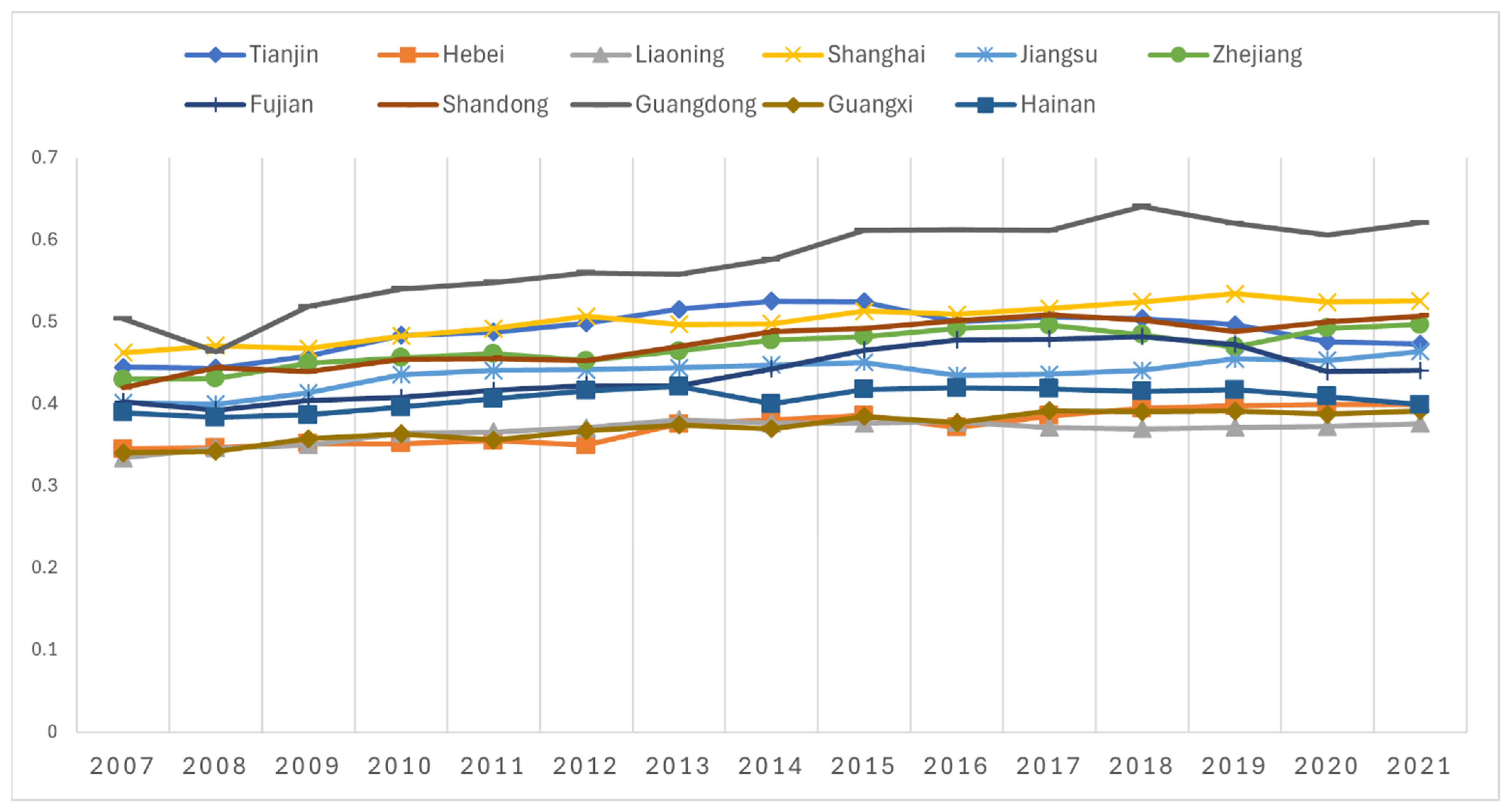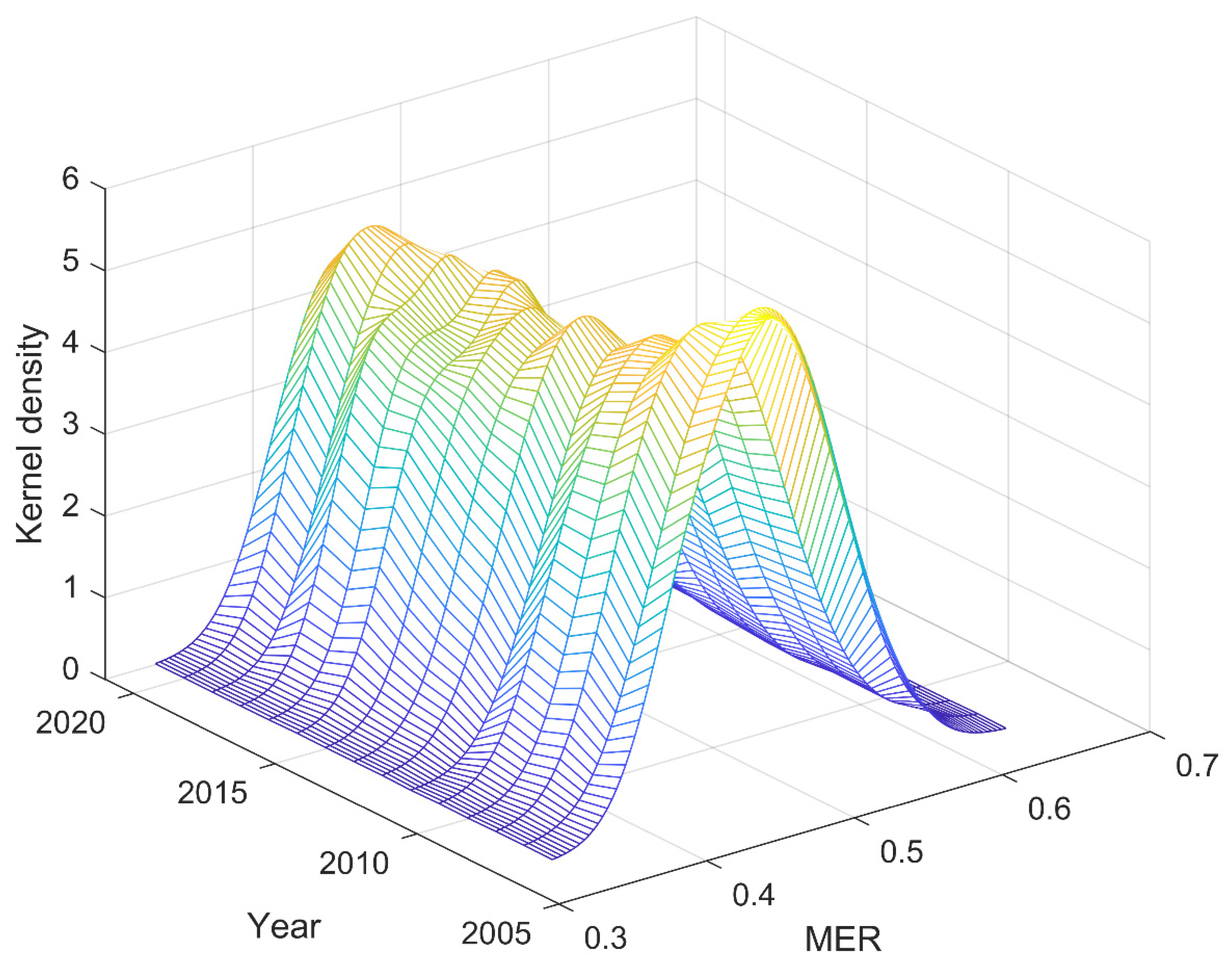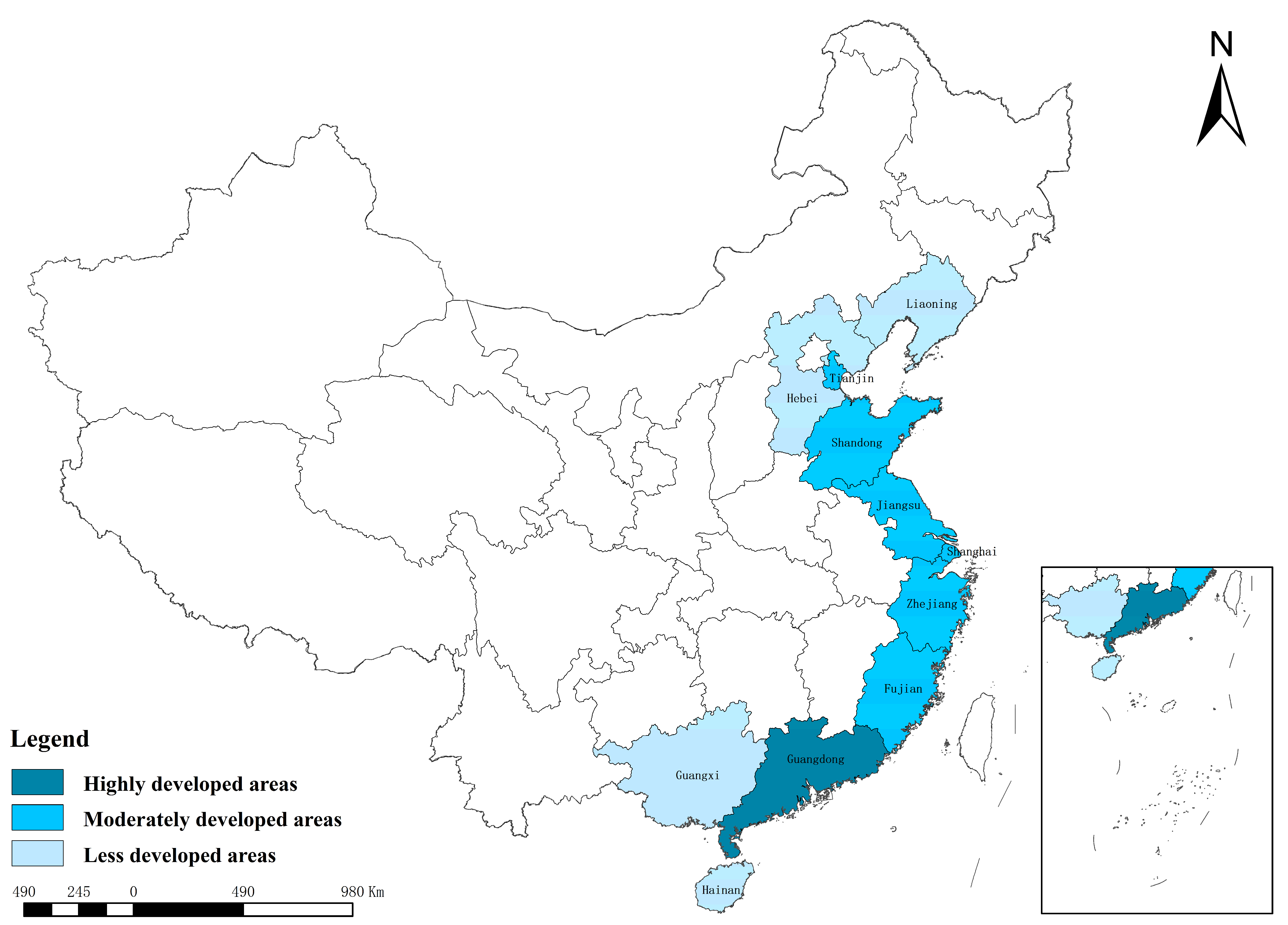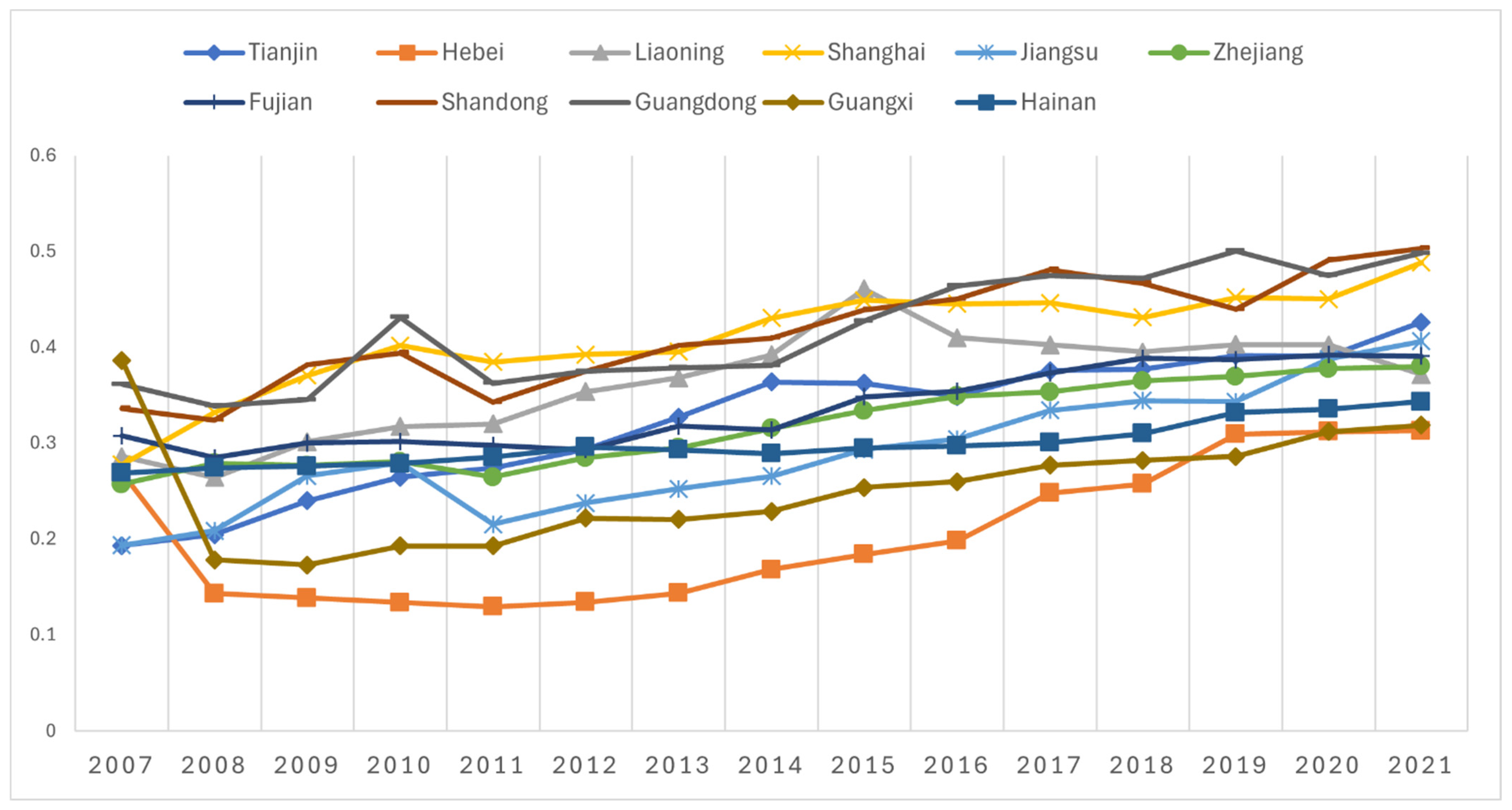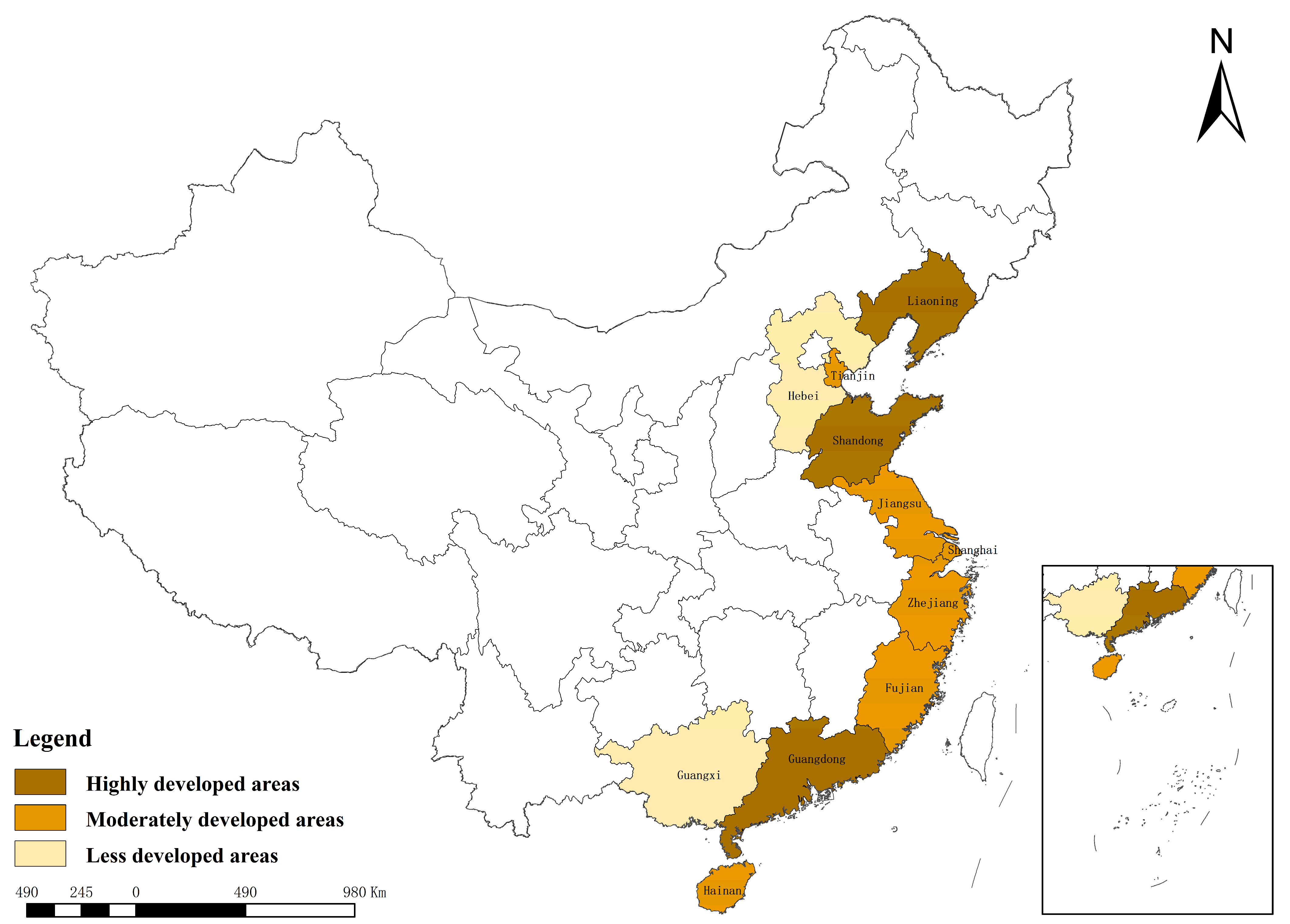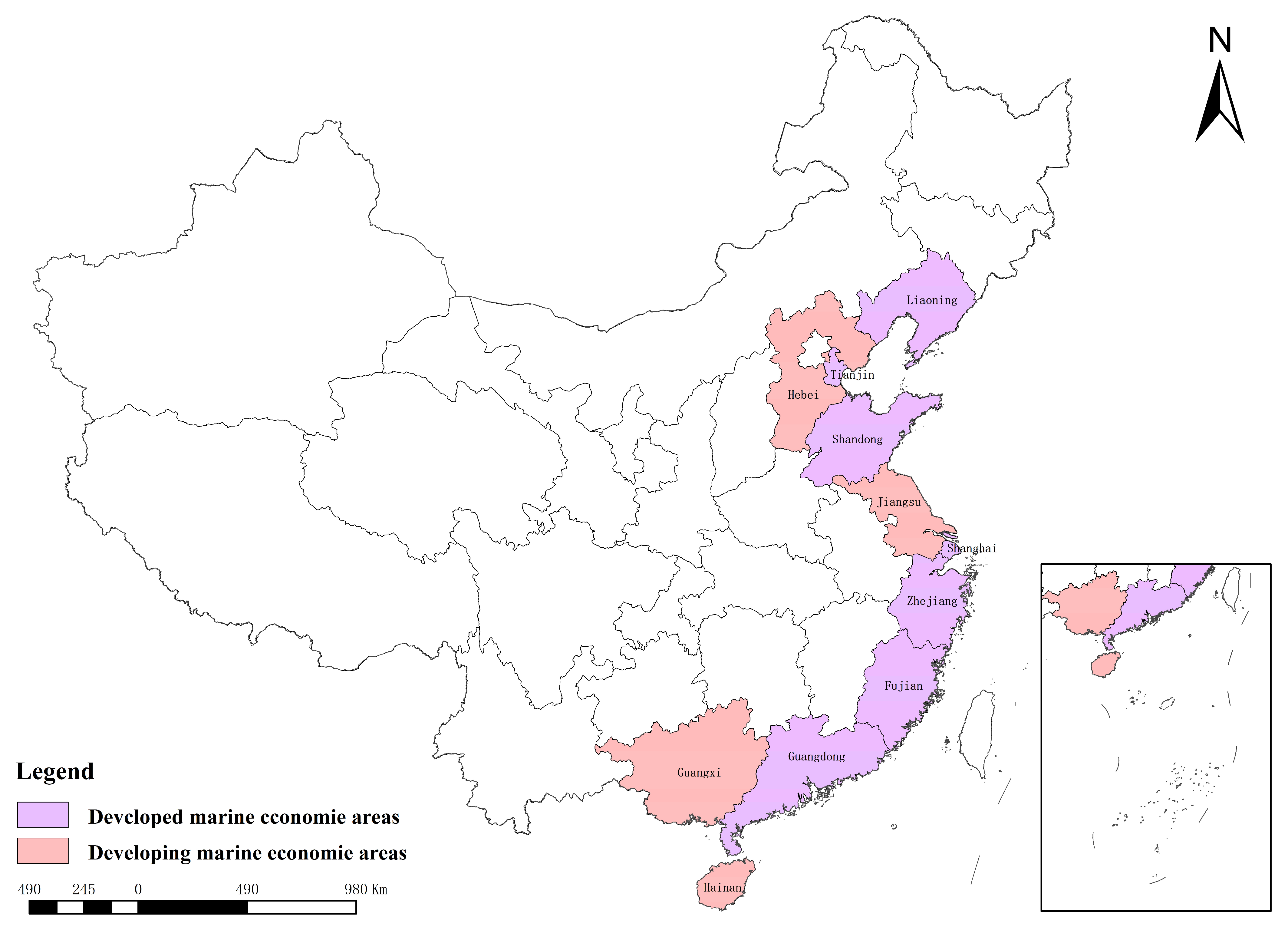1. Introduction
At present, China’s economy has shifted from a stage of rapid growth to one of high-quality development. The development of the land economy has attained significant magnitude and achieved notable progress. There are still some difficulties in breaking through the bottleneck of economic development in the short term. Thus, the expansion of the maritime sector has become an essential strategy for China’s economy to attain high-quality growth in the future. The ocean provides biological, mining, and energy resources for human survival and development, boosting associated businesses and improving human well-being. The ocean is a major technological battleground and a vital international cooperation channel. The marine economy has become a pillar of China’s national economic development and a new driver of high-quality economic development.
In contrast to the land economy, the marine economy is represented by significant openness, sensitivity to external forces, and relative complexity, presenting both environmental and market-based risks. It is more particularly vulnerable to internal and external risk shocks, such as extreme weather events, ocean-related natural disasters, and market volatility [
1]. The key to the stable development of marine economies is their resilience in the face of a variety of risks and shocks. This is also a necessary capability for the attainment of high-quality development of marine economies and the goal of becoming a strong maritime nation. However, unexpected natural disasters, public health emergencies, geopolitical conflicts, and other factors have weighed down the global and Chinese macroeconomies in recent years. China’s marine economy has also suffered, slowing growth. This has caused ecological damage, inefficient resource use, and poor marine product quality [
2]. Such issues consistently hinder the effectiveness and quality of marine economic development, indicating underlying vulnerabilities, namely, inadequate resilience. China has explicitly expressed the overarching assessment of “good national economic resilience” and the grand strategy to “build China into a strong maritime nation.” Therefore, strengthening marine economic resilience in China’s coastal areas against both internal and external risks and disturbances has become essential for its developing marine economy, becoming both an unavoidable path forward and a critical safeguard. The question of how to strengthen marine economic resilience has increasingly received attention from both academia researchers and industry professionals [
3,
4,
5].
At this critical phase of China’s economic transformation, the unsustainable extensive growth model applied by traditional productive forces, which depends on substantial inputs of production factors such as land, labor, and energy resources for economic gains, has resulted in drawbacks such as resource depletion and environmental degradation. Furthermore, it has proven insufficient to address intricate international challenges, thereby hindering the enhancement of economic resilience [
6]. Against this background, in September 2023, General Secretary Xi Jinping said “in order to integrate scientific and technological innovation resources, to take the lead in the development of strategic emerging industries and future industries, and to speed up the construction of new quality productive forces” during his visit to Heilongjiang, China [
7]. At the second session of the 14th National People’s Congress held in Beijing, the proposal of “striving to modernize the industrial system and developing new quality productive forces at a faster pace” was put forward, marking the first time that “new quality productive forces” was formally included in the government’s work report in March 2024 [
8]. New quality productive forces prioritize the function of new types of productive factors in economic progress, emphasizing the enhancement of both the quantity and quality of production factors through scientific and technological innovation as a means to attain the high-quality development of the economy [
9]. Since the concept of new quality productive forces was first proposed, it has been widely discussed in academia. New quality productive forces is a political and economic term with Chinese characteristics. It represents China’s revised comprehension of productive forces, informed by the technological revolution and significant transformations in production methods in the 21st century. It is an innovative benchmark for the development of productive forces in the context of Chinese-style modernization [
10,
11].
According to Marxist philosophy and methodology, General Secretary Xi Jinping pointed out that “it is crucial to firmly grasp the primary task of high-quality development and adaptively promote new quality productive forces according to local conditions” [
9,
12]. China is a major maritime nation that has about 3 million square kilometers of claimed waters and more than 18,000 km of continental coastline. Under the current background of building China into a strong maritime nation, accelerating the development of MNQPFs according to local conditions is expected to create a new engine for the development of the marine economy, and is of great significance for improving the sustainable development capacity of the marine economy and achieving the high-quality development of the Chinese economy [
13,
14]. Marine new quality productive forces (MNQPFs) represent an essential aspect in the adaptive development of new productive forces according to local conditions, facilitating the transformation and enhancement of industrial structures and production methodologies within the marine economy, while simultaneously presenting new opportunities and challenges for bolstering marine economic resilience in coastal areas [
15].
Previous research into new quality productive forces within the marine sector has mostly focused on how to assess and measure, promote the high-quality development of the marine economy or fishing economy, and encourage environmentally sustainable practices in the marine economy [
16,
17,
18,
19]. Certain researchers have evaluated the effects of new quality productive forces on urban and agricultural economic resilience through the perspective of economic resilience [
15,
20,
21,
22,
23,
24]. Current studies on new quality productive forces of economic resilience mostly focus on the theoretical level, yet their conceptual foundations are primarily anchored in the land economy, seldom addressing the complexity and special constraints of the marine economy. As a result, the only empirical research has a significant gap in applicability to the marine sector. So, what impact do MNQPFs have on marine economic resilience? To explore these questions, this study first constructed an evaluation index system for MNQPFs and marine economic resilience and measured and analyzed the levels of MNQPFs and marine economic resilience in 11 provinces and cities in China’s coastal areas. Second, the impact of MNQPFs on marine economic resilience was explored from multiple dimensions, with a view to providing theoretical reference and practical reference for continuously promoting the development of MNQPFs and further enhancing marine economic resilience. While providing strong support for the high-quality development of China’s marine economy, MNQPFs will also inject new momentum and opportunities into the global marine economy and, thus, have significant global significance and contemporary value. First, at a time when the global economy is facing unprecedented challenges ranging from geopolitical tensions to environmental crises, the proposal of MNQPFs provides new ideas for the sustainable development of the world economy, from which other countries can seek inspiration for their own development. Second, exploring the impact of MNQPFs on marine economic resilience will also provide a reference for countries located in coastal areas to explore marine economic issues, thereby bringing momentum to global economic recovery and contributing Chinese wisdom and strength to sustainable development [
25].
The main contributions are as follows: (1) This study introduces two novel index systems: one evaluating MNQPFs from the perspectives of new quality workers, new quality labor objects, and new quality labor resources, and the other evaluating marine economic resilience from the perspectives of resistance ability, recovery ability, and evolution ability. These systems offer a basis for measurement and analysis. (2) An empirical analysis is employed to determine the effects of MNQPFs on marine economic resilience, including the impacts on resistance ability, recovery ability, and evolution ability. Instrumental variable methods are utilized to account for potential endogeneity problems. (3) This study further discusses the heterogeneous impact of MNQPFs on marine economic resilience across varying levels of marine economic development level in coastal areas.
4. Result and Analysis
4.1. Analysis of the Measurement Results of Marine Economic Resilience
4.1.1. Analysis of Time Variation of Marine Economic Resilience
This study measured the marine economic resilience levels of 11 coastal provinces and municipalities in China from 2007 to 2021 using the entropy weight-Topsis method. Spatial classification was performed through the Jenks Natural Breaks Classification in ArcGIS 10.8.1, with results visualized in
Table 4 and
Table 5 and
Figure 1.
It can be observed from the figure that the level of marine economic resilience in Guangdong is significantly higher than that observed in other coastal areas, exhibiting an upward trend reflected by periodic fluctuations. The marine economic resilience of both Shanghai and Shandong demonstrated a steady upward trend, achieving the classification of a highly developed area in 2015 and 2016, respectively. However, Shandong experienced a decline in its level of marine economic resilience during the epidemic period. While levels of marine economic resilience in both Jiangsu and Zhejiang have reached the standard of a moderately developed area, both provinces continue to display a steady upward trend. The levels of marine economic resilience in Tianjin and Fujian have established them as moderately developed areas for an extended period, demonstrating a pattern of first rising and then declining. Hainan’s marine economic resilience has fluctuated near the critical point, separating middle and low development levels. Meanwhile, the levels of marine economic resilience in Hebei, Liaoning, and Guangxi have remained consistently low, while they too exhibit a steady upward trend.
This study also uses kernel density estimation to analyze the dynamic evolutionary characteristics of marine economic resilience levels in coastal areas over time and utilizes Matlab2022a to construct a three-dimensional kernel density estimation visualization,
Figure 2, depicting the overall level of marine economic resilience from 2007 to 2021. The examination of the results, from a locational standpoint, indicates a slight rightward shift in the kernel density distribution curve representing the overall resilience level. This displacement signifies a consistent pattern of positive growth in marine economic resilience throughout the coastal areas under study. From a morphological perspective, the primary peak’s height follows a “rise—fall—rise” trend while exhibiting increasing crest height and reducing width. This observation points toward a gradual convergence, or narrowing, of differences in marine economic resilience levels among these areas. Finally, considering both polarization trends and distribution ductility, the consistent maintenance of a single-peak configuration in the kernel density curve suggests that the overall developmental progress of marine economic resilience in these coastal areas does not exhibit any significant tendencies toward polarization.
Guangdong’s marine economic resilience has shown a fluctuating upward trend. Since 2008, the gap between Guangdong’s marine economic resilience and that of other coastal provinces and cities has gradually widened. The marine economic resilience levels of Fujian and Tianjin showed relatively large fluctuations after 2012 and 2013, respectively. The possible reasons are that Fujian and Tianjin became national marine economic development pilot areas in 2012 and 2013, respectively. With the vigorous development of the marine economy, the implementation of policies inevitably led to certain adjustments and changes in the marine economies of the two regions, resulting in large fluctuations in the marine economic resilience levels of Fujian and Tianjin in the following years. The marine economic resilience levels of the remaining coastal provinces and cities showed a slight upward trend during the study period.
4.1.2. Analysis of the Spatial Distribution of Marine Economic Resilience
This study calculates the mean value of marine economic resilience for 11 coastal provinces and cities from 2007 to 2021 and employs the Jenks Natural Breaks Classification in ArcGIS 10.8. The results are demonstrated in
Figure 3. Following established regional planning designations, these 11 coastal areas are categorized into three regions: the Bohai Sea region, including Liaoning, Hebei, Tianjin, and Shandong; the Yellow Sea and the East China Sea region, including Shanghai, Zhejiang, and Jiangsu; and the South China Sea region, including Fujian, Guangdong, Guangxi, and Hainan. The analysis of the spatial distribution indicates relatively low levels of marine economic resilience in the Bohai Sea region. Specifically, Liaoning and Hebei demonstrate lower levels of resilience, characterizing them as less developed regions, whereas Tianjin and Shandong exhibit moderate levels, suggesting moderate regional development. The Yellow Sea and the East China Sea region present a more positive picture, demonstrating generally robust marine economic resilience across all included provinces and cities, placing them in the moderately developed category. The South China Sea region presents a less uniform distribution of marine economic resilience. Guangdong stands out as the only province attaining the criteria for a highly developed area due to its high levels of marine economic resilience. Fujian demonstrates moderate resilience, placing it in the moderately developed category, while both Hainan and Guangxi exhibit lower levels of resilience, classifying them as less developed areas. In summary, marine economic resilience along the Chinese coast exhibits a pattern of lower resilience in both the northern and southern extremities, with comparatively higher resilience in the central coastal area. Guangdong’s exceptional performance, despite its location in the generally less resilient South China Sea region, is likely attributable to the combined advantages of abundant natural resources, unique policies, and geographical advantages. These factors contribute to a level of development in Guangdong that is significantly stronger than that observed in other coastal provinces and cities included in this study.
Overall, the marine economic resilience of China’s coastal regions exhibits a central high, northern–southern low spatial pattern. The Bohai Sea region initially developed its marine economy with a heavy reliance on secondary industries, particularly marine shipbuilding, chemical processing, and biomedicine, which are concentrated in its provinces and cities. This early industrial focus led to structural imbalances in industrial allocation and severe marine pollution. Despite ongoing efforts since the early 21st century to adjust the region’s marine economic development pathways, achieving some progress, the deep-rooted issues inherited from its early-stage growth remain unresolved and will require a long-term process of remediation. Consequently, the marine economic resilience of provinces and cities within the Bohai Sea region has persistently remained at low-to-medium levels. For the South China Sea region, the area has vast seas and abundant marine resources, including fishery resources, marine energy, marine tourism, etc. Therefore, the leading marine industries in the region are mainly the primary marine industries represented by marine fisheries, and the tertiary marine industries are represented by coastal tourism and marine transportation. The entire region has not yet achieved a balanced industrial structure. Among them, Guangdong’s marine economy started early, has a high level of technology, a complete range of marine industries, and a solid foundation and strong strength in the marine economy. The level of development of its marine economy is much higher than that of other provinces in the South China Sea region, resulting in the greatest degree of internal difference in the level of marine economic resilience in the South China Sea region [
70]. In contrast, the Yellow Sea and East China Sea regions—Jiangsu, Zhejiang, and Shanghai—benefit from superior geographical positioning, strong economic foundations, and well-developed shipping systems. These provinces exhibit uniformly high levels of marine economic development with relatively smaller internal disparities; therefore, the overall marine economic resilience of these regions demonstrates a positive trajectory.
4.2. Analysis of the Measurement Results of Marine New Quality Productive Forces
4.2.1. Analysis of Time Variation of Marine New Quality Productive Forces
This study employs a panel data entropy weight-Topsis method to calculate the levels of MNQPFs in 11 coastal provinces and cities from 2007 to 2021. The results are presented in
Table 6 and
Figure 4. Calculations indicate an average annual growth rate of 2.34% for coastal MNQPFs. Guangdong exhibits the highest level, at 2.04 times that of Hebei, which demonstrates the lowest level.
Figure 4 illustrates that China’s coastal MNQPFs followed a generally upward trend, albeit with fluctuations, from 2007 to 2021, including a period of significant growth. The difference in MNQPF levels between provinces appears to be decreasing over time. Shandong, Shanghai, and Guangdong maintain relatively high levels of MNQPFs, while Tianjin, Fujian, and Jiangsu exhibit intermediate levels, all demonstrating a fluctuating upward trend. Guangxi and Hebei consistently register the lowest levels of MNQPFs; however, both exhibit a pattern of large fluctuation and growth. Hainan occupies a mid-range level, represented by steady growth. Liaoning’s MNQPFs initially rose to a relatively high level before then declining.
4.2.2. Analysis of Spatial Distribution of Marine New Quality Productive Forces
This study computes the mean value of marine economic resilience of 11 coastal provinces and cities from 2007 to 2021. Employing the Jenks Natural Breaks Classification, these areas are categorized, and ArcGIS10.8.1 was used to create a spatial distribution map. The analysis was based on the regional distribution plan described earlier. The results are shown in
Table 7 and
Figure 5. As indicated in
Table 7, Shandong, Liaoning, Guangdong, and Shanghai represent highly developed areas. Tianjin, Fujian, Jiangsu, and Zhejiang are classified as moderately developed areas, while Guangxi and Hebei are less developed areas.
Figure 5 indicates that the spatial distribution of MNQPFs exhibits similar characteristics in the Bohai region and the South China Sea regions, each including highly developed, moderately developed, and less developed areas, whereas, the Yellow Sea and East China Sea region demonstrates a more balanced distribution in the development level of these marine forces. Situated at the heart of the Yangtze River Economic Belt, Shanghai benefits from strong economic strength, a rich talent pool, and a concentration of innovation resources. And, its MNQPFs maintain a leading position, solidifying its status as a highly developed area. Zhejiang and Jiangsu, building upon robust economies and strong developmental foundations, further benefit from Shanghai’s radiating influence and driving force. This results in a high level of MNQPFs in these provinces, suggesting significant growth potential [
71].
Among the highly developed areas, Shandong, Guangdong, Liaoning, and Shanghai have large populations. Among them, Guangdong and Shanghai have developed marine emerging industries and relatively complete marine infrastructure; Shandong and Liaoning have a number of marine colleges and universities and national marine research institutes, with a high reserve of talent in the marine sector. Although Liaoning’s marine economy is relatively weak compared with Shandong, Shanghai, and Guangdong, its marine ecological environment is superior. Therefore, these four regions have more advantages and potential for the development of MNQPFs [
72]. Among the moderately developed areas, Tianjin and Zhejiang have a relatively high level of marine economic development, but their populations are relatively small, and Hainan also has a relatively small population. Jiangsu’s marine economy is dominated by the secondary marine industries. Fujian has relatively few universities and research institutes related to the sea, and the reserve of talent related to the sea needs to be strengthened. These five areas still have shortcomings in the development of MNQPFs and there is still much room for improvement. Among the less developed areas, Hebei and Guangxi have a relatively weak marine economy, with relatively single industry marine industries. Guangxi is adjacent to Guangdong, and Hebei is adjacent to Beijing, making it difficult to effectively attract and retain talent, all of which leads to a low level of MNQPFs in these two areas.
4.3. Benchmark Regression
Based on the theoretical analysis in the previous section, this section mainly explores the impact of marine new quality productive forces on marine economic resilience. The benchmark regression method used is panel regression. Before performing panel regression analysis, the Hausman test is performed to select a random effects model or a fixed effects model for regression analysis. The Hausman test showed that the chi-square statistics for marine new quality productive forces on marine economic resilience, the resistance ability of marine economic resilience, the recovery ability of marine economic resilience, and the evolution ability of marine economic resilience were 7.04, 31.01, 6.16, and 27.33, respectively, with p-values of 0.008, 0.000, 0.046, and 0.000, which are all less than 0.05. This indicates that the model rejects the original hypothesis that “individual effects are not correlated with explanatory variables”, that is, the analysis can use a fixed-effects model. Therefore, this paper uses a two-way fixed effects model for testing.
The presence of multicollinearity among the selected variables could lead to instability in the model’s estimation results, potentially producing misleading conclusions. For this reason, variance inflation factors (VIFs) are used in the model. The resulting VIF values exhibit a maximum of 2.32 and an average of 1.79, indicating the absence of multicollinearity among the explanatory, explained, and control variables. Therefore, these variables can be further analyzed.
Column (1) of
Table 8 demonstrates the regression results of the impact of the MNQPFs on marine economic resilience. The regression coefficient is 0.041 and it is significant at the 5% significance level. This means that, for every 1 unit increase in the development level of MNQPFs, marine economic resilience increases by 0.041 units. Therefore, MNQPFs play a significant role in promoting the improvement of marine economic resilience. This verifies Hypothesis 1. Considering that the aforementioned marine economic resilience index system consists of three dimensions: resistance ability, recovery ability, and evolution ability, and since balanced development among these dimensions is crucial for the sustainable improvement of marine economic resilience, this study further analyzes the impact of MNQPFs on these three dimensions. Columns (2)–(4) of
Table 8 present the regression results of MNQPFs on the resistance ability, recovery ability, and evolution ability of marine economic resilience, respectively. The impact of MNQPFs on resistance ability is positive and significant at the 1% level, with a regression coefficient of 0.18. The impact on recovery ability is also positive and significant at the 5% level, with a coefficient of 0.324. While the impact of MNQPFs on the evolution ability of marine economic resilience is positive, with a regression coefficient of 0.017, it is not significant. The reason why MNQPFs do not have a significant positive impact on the recovery ability of marine economic resilience may be that the recovery ability of marine economic resilience is related to the stability of the marine economy, its ability to respond to shocks, and the extent of losses. In the process of developing MNQPFs, it is inevitable to rely on the continuous and large-scale investment of marine resources and high energy consumption. Although some resource-intensive technologies can rapidly increase production capacity, they will cause hidden damage to ecological carrying capacity. Moreover, the extensive development model and excessive exploitation of marine resources in some coastal areas may cause imbalances in the marine economic structure and make the marine ecological environment increasingly sensitive and vulnerable, thereby weakening the stability and shock response ability of the marine economy and causing more serious losses. The recovery of the marine economic structure and the marine ecological environment requires more effort and time. Therefore, under such circumstances, the positive effect of MNQPFs on the recovery ability of marine economic resilience is not obvious [
73].
4.4. Robustness Test
In order to make the regression process more rigorous and to demonstrate the robustness and reliability of the above analysis, a robustness test of the model is further conducted here.
First, this study conducts a robustness test by excluding the influence of unobservable factors and replacing control variables. Second, in order to solve the endogeneity problem caused by reverse causality, and taking into account the time lag nature of the impact of marine new quality productive forces on marine economic resilience, that is, whether the impact of the current marine new quality productive forces on the development of marine economic resilience is similar to the impact of the previous marine new quality productive forces on the development of marine economic resilience, this study uses the lagged marine new quality productive forces as an explanatory variable for regression analysis to test the robustness of the results.
- (1)
Excluding the influence of unobservable factors
Considering the complexity of the real economic environment, the marine economic system often suffers from multidimensional shocks, and the intensity of the response to these shocks varies in each region at the same time, which may have a different impact on the observation results. This study incorporates the interaction of area and year as a fixed effect into the baseline regression model to address the problems caused by these unobservable variables that change over time and vary between individuals. This method is particularly suitable for analyzing the differentiated adjustment mechanisms of different economic systems in the face of multidimensional shocks. The results are shown in
Table 9, and the regression results after controlling for area and year-related factors remain robust.
- (2)
Replacement of control variables
Among the original control variables, this study selected the ratio of foreign direct investment to GDP to represent the impact of the degree of openness. When performing the robustness test, the ratio of total import and export volume to GDP was selected to replace the ratio of foreign direct investment to GDP. The newly introduced control variable is denoted by Re-open. The test results are shown in
Table 10, which are basically consistent with the benchmark regression results.
- (3)
Endogeneity discussion
The use of lagged explanatory variables can alleviate the endogeneity problem of mutual causality to a certain extent.
The regression results presented in
Table 11 demonstrate that MNQPFs, lagged by one period, exert a significant positive impact on the overall level of marine economic resilience and its two dimensions: resistance ability and recovery ability. Specifically, these lagged forces demonstrate a significant positive impact on the recovery dimension of marine economic resilience. This result shows that the impact of MNQPFs begins to take effect from the current period. However, by observing the value of the coefficient, it is found that the impact of MNQPFs on marine economic resilience in the previous period is even stronger. This result emphasizes the dynamic cumulative effect of MNQPFs. Coastal areas must continue to cultivate the quantitative accumulation of MNQPFs to facilitate a qualitative advancement in these forces and establish a growth trend. This sustained development is crucial to enhancing marine economic resilience [
74]. In addition, the lagged one-period MNQPFs positively contribute to marine economic resilience, with significance at the 5% level. This result demonstrates that temporal elements significantly constrain marine economic resilience. Secondly, it suggests that the impact of MNQPFs on marine economic resilience needs to be progressively revealed, and the time cost is relatively significant.
4.5. Heterogeneity Analysis
Based on the theoretical analysis above, this article, in accordance with the content of the 13th Five-Year Plan for the Development of the National Marine Economy, the functional stratification of the three major economic circles, the layout of the core urban agglomerations, and the objective gaps in the industrial structure, innovation capacity, and resource utilization efficiency of each province, clearly divides the regions participating in the construction of global marine central cities into developed marine economic areas, including Liaoning, Tianjin, Shandong, Shanghai, Zhejiang, Fujian, and Guangdong; the regions not participating in the construction are divided into developing marine economic areas, including Jiangsu, Hebei, Guangxi, and Hainan. Jiangsu, Guangxi, and Hainan have a certain foundation in the marine economy, but they do not meet the standards set by the plan for “global marine central cities” or “international industrial highlands”, and are, therefore, classified as developing marine economic areas. The results of the division are shown in
Figure 6.
This study carries out an empirical analysis comparing these developed and less developed areas. Column (1) of
Table 12 presents the regression results demonstrating the impact of MNQPFs on marine economic resilience in developed marine economic areas. The regression coefficient, 0.0549, is significant at the 10% level. Column (2) presents the regression results demonstrating the impact of MNQPFs on marine economic resilience in developed marine economic areas, obtaining a coefficient of 0.0575. This value is greater than that observed for developed areas and achieves significance at the 1% level. This analysis confirms Hypothesis 2.
5. Conclusions and Suggestions
To explore the relationship between MNQPFs and marine economic resilience, this study draws upon panel data from 11 coastal provinces and cities in China, covering the period from 2007 to 2021. Initially, this study establishes an innovative index system for both MNQPFs and marine economic resilience, enabling an assessment of their respective developmental levels across the 11 coastal provinces and cities. Then, utilizing a two-way fixed effects model, this study analyzes the impact of MNQPFs on marine economic resilience and discovers the underlying internal mechanisms at play. The primary conclusions of this research are as follows: (1) Measurements show that there are significant differences in the levels of marine new quality productive forces between different regions. Guangdong, Shandong, Liaoning, and Shanghai have shown good levels of development; Fujian, Zhejiang, Tianjin, and Jiangsu each have certain shortcomings in their development; and Guangxi and Hebei have weak levels of development of MNQPFs. In addition, the Bohai Sea region and the South China Sea region have similar spatial distributions of MNQPFs, while the Yellow Sea and East China Sea region has a more balanced level of development. (2) Calculations show that Guangdong has the highest level of marine economic resilience, consistently ranking first and far above the other provinces and cities. The most provinces and cities are in the moderately developed areas, including Zhejiang, Shanghai, Jiangsu, Shandong, Fujian, and Tianjin. Hainan, Guangxi, Hebei, and Liaoning have a lower level of marine economic resilience. In addition, the overall marine economic resilience of coastal areas shows that the Bohai Sea region is developing weakly, the South China Sea region is developing unevenly, and the Yellow Sea and East China Sea region is developing well. (3) Marine new quality productive forces have a significant positive impact on marine economic resilience. From the perspective of the three dimensions of marine economic resilience, marine new quality productive forces have a significant role in promoting the resistance ability and evolution ability of marine economic resilience, while they exhibit a positive role in promoting the recovery ability of marine economic resilience only in the second year. (4) The promotion impact of marine new quality productive forces on marine economic resilience will be affected by the heterogeneity of the level of marine economic development in coastal areas, and the positive promotion impact of marine new quality productive forces on marine economic resilience in less developed marine economic areas is stronger.
According to the conclusions of this study, the following policy suggestions are put forward:
- (1)
Construct a differentiated regional collaborative mechanism to optimize the spatial layout of MNQPFs
Policies for differentiated guidance and regional collaboration should be implemented according to the development shortcomings and spatial distribution characteristics of MNQPFs in different areas. For leading provinces such as Guangdong and Shandong, their universities and scientific research institutions can increase the training of innovative talent in marine science and technology to optimize the layout of national scientific and technological strength for the national maritime strategy, continuously innovate the scientific research ecosystem, further improve the quality and quantity of maritime laborers, and strengthen their capacity for technological innovation and industrial radiation. For areas with shortcomings, such as Fujian and Zhejiang, the government can set up special funds to support the development of emerging marine industries, guide capital investment into emerging marine industries, focus on filling the gaps in marine digital infrastructure and the green energy industry chain, accelerate the transformation and upgrading of traditional marine industries, and cultivate and expand strategic emerging marine industries. For less developed areas such as Guangxi and Hebei, the government should promote the enhancement of their marine economic strength through cross-regional technology transfer and special fund support. The government should also continue to increase funding for marine scientific research, guide and encourage universities and enterprises in these areas to increase investment in research and development, and especially increase investment in the construction of digital infrastructure to create a good hardware and software environment for cultivating MNQPFs.
- (2)
Strengthen the infrastructure and industrial upgrading in areas with weak marine economic resilience
For areas with low levels of marine economic resilience, such as Hainan and Guangxi, priority should be given to improving the infrastructure for marine disaster prevention and reduction and optimizing and improving the marine industrial policy system. For example, Hainan needs to strengthen the risk resistance of its ports, and Guangxi should lay out marine ecological restoration and high-value-added industries. For the Bohai Sea region and the South China Sea region, the upgrading and transformation of the marine industrial structure in coastal areas should be accelerated, and the development of the marine economy should be promoted at the policy level. For example, the transformation of traditional fisheries to smart aquaculture should be promoted to reduce the proportion of environmentally dependent industries. In addition, all areas need to strengthen the protection and restoration of the marine ecological environment, enhance the restoration function of the marine ecosystem in coastal areas, provide a good ecological environment to support the development of the marine economy, and thereby enhance marine economic resilience.
- (3)
Promote the leapfrog development of underdeveloped marine areas and promote the balanced development of the coastal areas’ economies
Since MNQPFs have a stronger role in promoting the marine economic resilience of underdeveloped marine economic areas, it is recommended that special technical support plans be implemented in Hebei, Guangxi, and other places. For example, a marine science and technology development fund could be established to support localized innovation and marine-related enterprises could be introduced through tax incentives to develop emerging marine industries. Ultimately, the rapid development of the marine economy will be achieved by developing MNQPFs. For developed marine areas, the focus should be on technology spillovers. Scientific research institutions in Shandong, Shanghai, and other places should be encouraged to jointly establish laboratories with less developed areas, establish cross-regional cooperation mechanisms, share resources and advantages, improve the planning system and management mechanism, and promote the balanced development of the marine economy in coastal areas. Only in this way can the role of MNQPFs in enhancing marine economic resilience be better utilized.
This study verifies for the first time that MNQPFs in the marine sector can enhance marine economic resilience and constructs an evaluation index system for MNQPFs and marine economic resilience. In addition, this study effectively and comprehensively reflects the impact of new quality productivity in different dimensions and regions on the growth of marine economic resilience, enriching research on the relationship between the two in the marine field. This study provides a scientific reference for the sustainable development of the marine economy and the cultivation of MNQPFs in coastal areas around the world. However, this study still has limitations, and the spatial effects of MNQPFs on marine economic resilience deserve further exploration.
